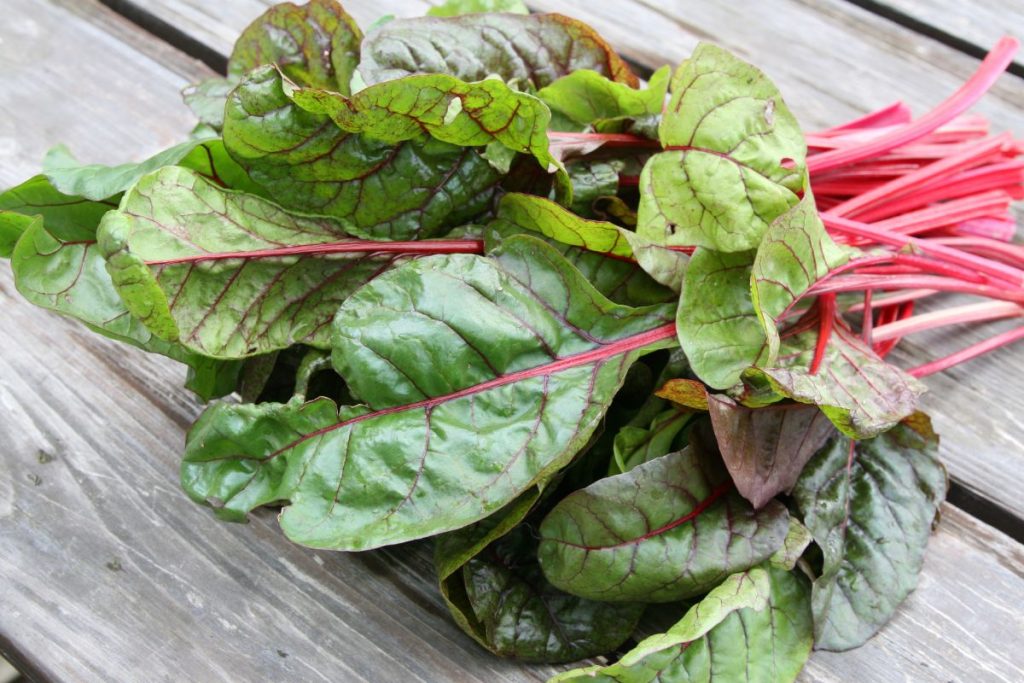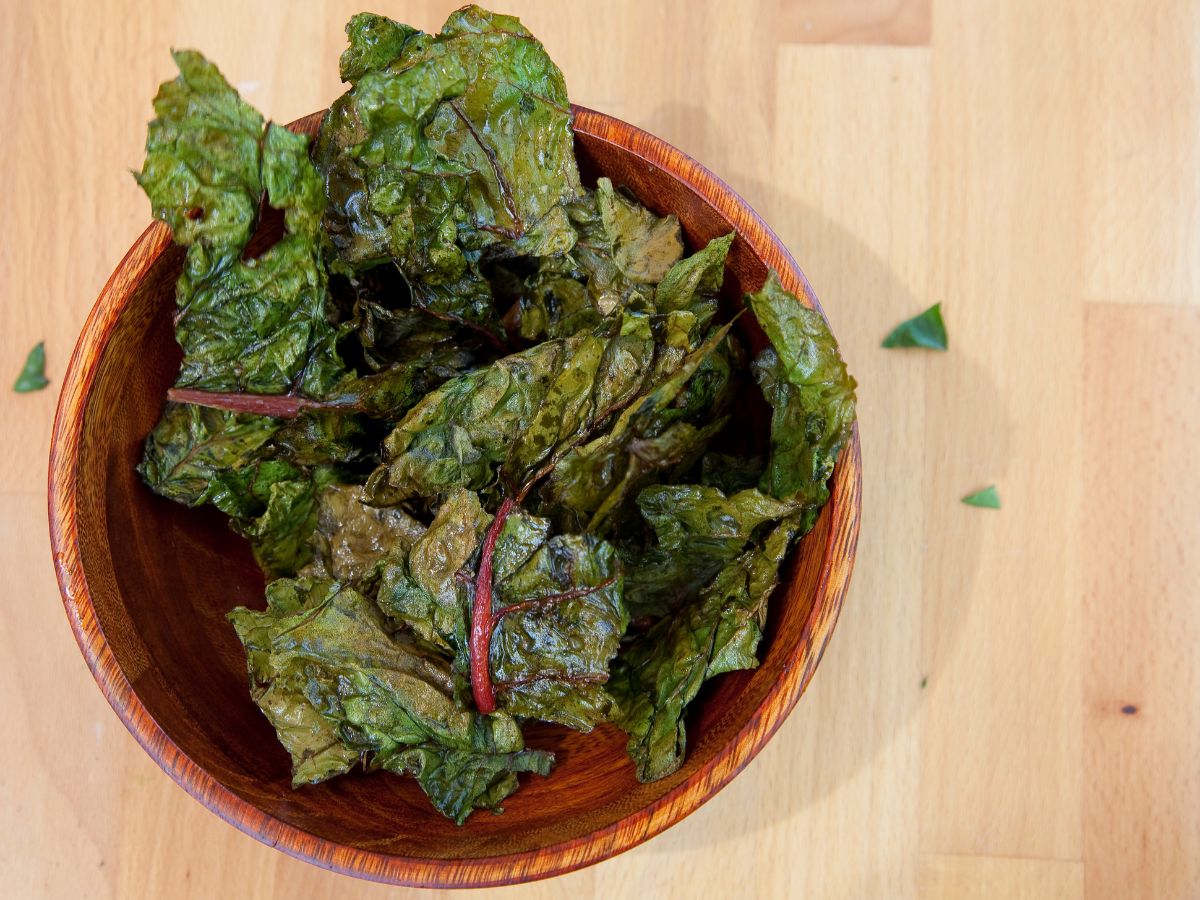The best way to dehydrate Swiss chard is to dry it in a food dehydrator at 135°F for 2-3 hours until crispy. To make dehydrated chard chips, bake the leaves in an oven for 8-10 minutes at 400°F until crispy.
Table of Contents
What is the Best Way to Dehydrate Swiss Chard?
The best way to dehydrate Swiss chard is to dry it in a food dehydrator—it carries a lower risk of cooking or burning the leaves.
- Rinse Swiss chard under cool running water.
- Use paper towels or a salad spinner to remove excess water.
- If preferred, remove the stems and center ribs. These are juicier and will increase the drying time. Dry them separately or set them aside to use these pieces in a stew or soup.
- Cut the fresh chards into 4-inch pieces using a sharp knife.
- Blanch the Swiss chard pieces in boiling water for one minute. Take them out of the water and shock them in ice water to avoid further cooking.
- Blot the blanched chard with paper towels to remove excess water.
- Spread the pieces flat on dehydrator trays. Ensure they don’t overlap and leave spaces between them for proper air circulation.
- Set the dehydrator to 135°F and dry the chard for 2-3 hours until crispy.
- Take out a few pieces and allow them to cool to room temperature. Test for dryness. If fully dry, remove the Swiss chard leaves and cool them.
- Put the dried Swiss chard leaves in airtight food storage containers and condition them for up to seven days. Shake the containers once daily.
- Store the dry Swiss chard in airtight containers in a cool, dry, dark place.

Swiss Chard Chips Recipe
- Total Time: 15 minutes
Description
Oven-baked Swiss chard chips are an excellent alternative to potato and dehydrated kale chips. Here’s a recipe to help you make chard chips in minutes.
Ingredients
- 4 cups of Swiss chard leaves
- 4 teaspoons of olive oil
- 1 pinch of pepper
- 1 tsp of salt
Instructions
- Wash the whole chard leaves with cold water in a big bowl. Remove them from the water and dry them with a salad spinner or paper towels.
- Remove the stems and center ribs from the leaves. Cut the leaves into 2-4 inch pieces.
- Preheat the oven to 400°F.
- Lightly brush a baking sheet with 2 teaspoons of olive oil.
- Arrange the cut leaves in a single layer on the oiled baking sheet and toss them with the remaining olive oil. Massage the leaves with your hands to apply the olive oil evenly.
- Sprinkle pepper and salt over the oiled leaves.
- Load the cookie sheet into the oven and bake the leaves for 8-10 minutes at 400°F.
- Flip the leaves after the 4th or 5th minute to ensure both sides get crispy.
- Remove the crisp leaves from the oven and enjoy immediately.
- Prep Time: 5 minutes
- Cook Time: 10 minutes
Nutrition
- Serving Size: 10 chips
- Calories: 42kcal
- Sugar: 1g
- Sodium: 86mg
- Fat: 4g
- Saturated Fat: 1g
- Carbohydrates: 1g
- Fiber: 1g
- Protein: 1g
How Long Does it Take to Dehydrate Swiss Chard?
It takes 2-3 hours to dehydrate Swiss chard in a food dehydrator at 135°F.
If you dry them in an oven, it will take 4-5 hours to dry Swiss chard at 150°F.
Do You Need to Blanch Swiss Chard Before Dehydrating?
You must blanch Swiss chard before dehydrating it, especially if you plan on consuming it raw in salads or smoothies.
Like other dried greens, Swiss chard contains oxalates, which can cause stones to form in your urinary tract. Blanching is necessary to dissolve these oxalates in water.
To blanch your Swiss chard, submerge it in boiling water for one minute. Take them out and dip them in ice water immediately to end the cooking process.

What are the Benefits of Dehydrating Swiss Chard?
There are many reasons to dehydrate Swiss chard, including:
- Swiss chard is a leafy vegetable and is rich in antioxidants like lutein, flavonoids, and beta-carotene
- Dried vegetables take up less storage space than fresh veggies
- Easily turn dehydrated Swiss chard into green powder for healthy smoothies
- Leafy greens contain beta-carotene, vitamin A, lutein, zeaxanthin, and vitamin C, which enhance eye health
- Swiss chard is rich in vitamin A, which aids in the function of body organs
- The high fiber content in dehydrated greens helps lower blood sugar levels
- The iron in Swiss chard helps lower the risk of anemia
How to Rehydrate Swiss Chard for Meals
Before using dried Swiss chard in raw foods, rehydrate it first by soaking it in boiling water for 5-10 minutes.
Dried Swiss chard that goes into cooked dishes like stews, casseroles, and soups doesn’t require rehydrating. Simply put the dried vegetable into the dish and reconstitute it with the cooking liquid.

How to Condition and Store Swiss Chard
Conditioning dehydrated food involves storing it in airtight containers and observing it for several days to ensure it is fully dry.
To condition dried Swiss chard put it in a clear glass jar for up to seven days. Shake the container daily and ensure the leaves do not stick together or form condensation.
Store fully dried and conditioned Swiss chard in airtight containers in a cool, dry, dark place for long-term storage.
What is the Shelf Life of Dehydrated Swiss Chard?
The shelf life of dehydrated Swiss chard is 1-2 years when it’s stored in airtight containers in a cool, dry, dark place.

